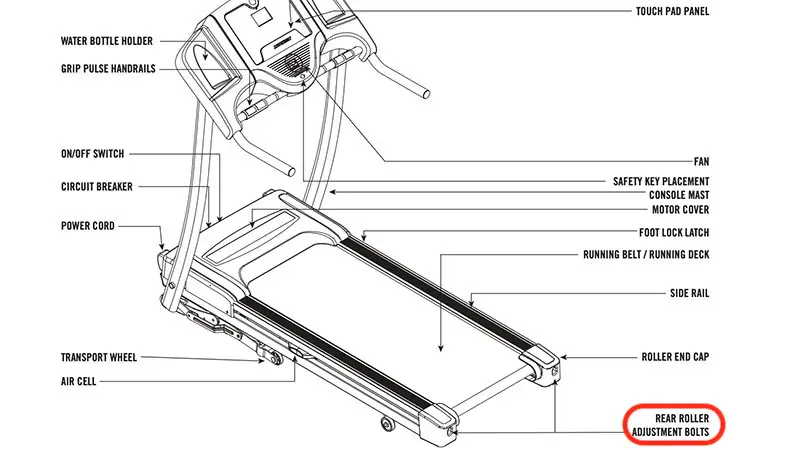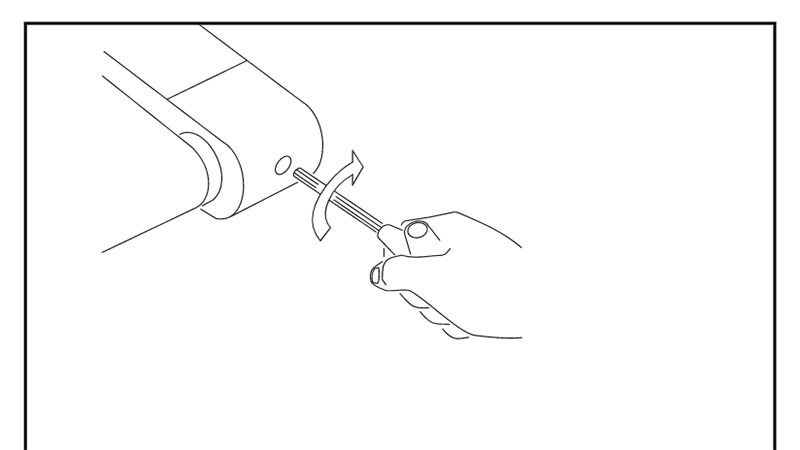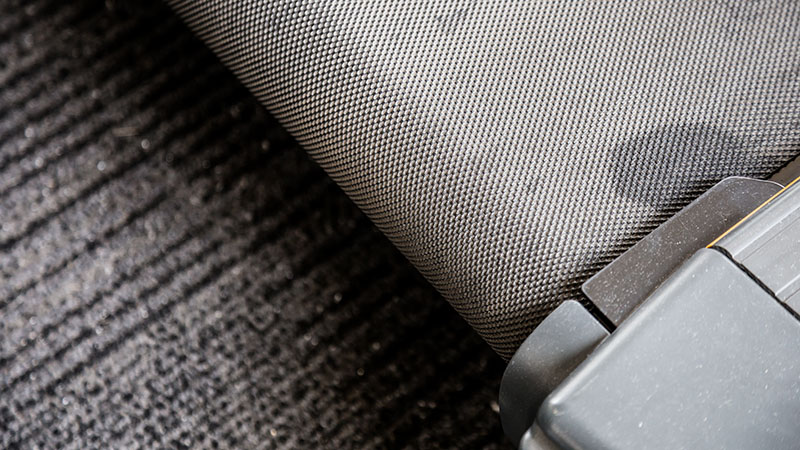Contents
- How To Tighten a Treadmill Belt
- Why Do Treadmill Belts Need Tightening?
- When a Treadmill Belt Needs Adjusting
- Setting the Tightness of a Treadmill Belt
- Adjusting Treadmill Belt With Treadmill On
- Adjust Treadmill Belt With Treadmill Off
- Why Do Treadmill Belts Need Adjusting?
- Tightening a Treadmill Belt – Bottom Line
Related: 12 Best Treadmills Under 1000 Dollars, 6 Best Treadmills Under 2000 Dollars, 7 Best Curved Treadmills for Sale
How To Tighten a Treadmill Belt
Knowing how to tighten a treadmill belt can save you money on repairs and get you right back into your workouts faster than waiting on a technician to arrive.
But before you can get started on your repair, you need to know a little about treadmills, how they work, and when they need servicing.
If that sounds like a lot, don’t worry.
Our guide to how to tighten a treadmill belt will make it easy.
Why Do Treadmill Belts Need Tightening?

Much like barbells or other home gym equipment, treadmill belts take a fair amount of abuse.
That’s because as they roll at our desired speed, we’re walking or running on top of them.
Even if you are pretty gentle during your workouts, treadmill belts may over time loosen.
A loose belt can slip, posing a tripping hazard to anyone using the treadmill.
Plus, an excessively loose belt can put extra stress on the motor, shortening its life.
Treadmill belts can also be too tight, which poses its own set of risks to the user.
So, you should always keep your belt at the proper tightness.
Keep in mind that not everyone wants the belt set the same way.
For example, runners with long strides might prefer a slightly looser belt than a very light person that walks slowly.
It’s up to you to set your belt how you like it.
When a Treadmill Belt Needs Adjusting
If you don’t think your treadmill belt needs tightening, it very well might not.
That’s because if you don’t notice any issues while using it, it’s working properly.
Anytime you’re running or walking on a treadmill, and the belt seems to slip, it’s a sign the belt is too loose and needs tightening.
If you feel like your strides are out of sync with the motion of the belt, it needs adjusting.
Even the best curved treadmills may need adjustments from time to time.
You should periodically check your belt for tension and position.
To check the tension, grasp the edges of the belt while the unit is off, and lift it up off the deck.
There should be at most about two inches of slack. If it seems loose, it might just need tightening.
If you notice the belt seems to stretch much farther than it did during your last inspection, it’s a sign your belt is stretching and may need replacement.
A stretched belt may eventually slip off the roller, so don’t use your treadmill until you’ve replaced it.
You should also look at the position of your belt and make sure it’s in the middle of the deck.
If it has shifted to either side, it’s no longer centered on the roller.
You can also adjust the belt’s position from right to left as part of your maintenance.
It’s usually pretty straightforward, and you can do it with the same tools you used to tighten the belt.
You can even do it at the same time.
Setting the Tightness of a Treadmill Belt
Tightening a treadmill belt is pretty straightforward. Don’t let this easy fix set you back on your cardio routine.
You’ll probably need a couple of tools to get started.
We recommend having a flat head screwdriver in case you need to pry off a cover to access the adjusting screws.
And almost all treadmills require a properly sized hex wrench (sometimes called an Allen wrench) to make your adjustments to the belt tension.
If you don’t have a set of Allen wrenches, they’re usually pretty easy to find in a hardware store and they’re relatively inexpensive too.
There are two methods you can follow.
One is done with the treadmill off, and we perform the other with the treadmill running.
It’s up to you which method you prefer, and they’re quite similar.
But, it’s much easier to adjust your belt with the treadmill running slowly.
That’s because you can see the changes as you make them.
Adjusting the belt while the treadmill is off means you have to start it up and shut it down repeatedly to check your work.
Adjusting Treadmill Belt With Treadmill On
Here’s each step of the process for tightening a treadmill belt while it’s on.
Before you make adjustments, be sure to check for other issues that might cause operational problems.
Inspect the belt for rips, gaps, or signs of excessive wear.
Don’t use a treadmill with a belt that fails your inspection. Instead, replace the belt.
Since the rollers turn the belt, they are essential for keeping it moving properly.
You should also make sure that you’ve performed any lubrication required by your treadmill’s manufacturer.
Check your owner’s manual for instructions on how to lube the roller, what kind of lubricant to use, and how often you should do so.
Always perform any required maintenance before using a treadmill.
Find the Adjusting Screws

You don’t need the treadmill running for this step.
Typically, treadmills have a pair of screws at their rear, near the axle of the back roller.
They’re usually easy to find, but if you have trouble, you can always check your owner’s manual.
If you look to the side rails near the very back of the machine, you’ll either see recessed adjusting screws or a service door you must remove to access them.
Make sure you have the right size hex wrench for your particular model treadmill.
Sometimes, an Allen wrench might not fit the adjusting screw.
You might need a Torx, star, flathead, Philips, or another bit on an adjustable screwdriver.
Turn the Treadmill On
Once you press the button and power on the treadmill, set the speed to 2 miles per hour (MPH).
If your treadmill doesn’t go that low, you can set it at anything up to 3 (MPH).
Adjust the Belt

Using the screws you found at the back of the treadmill, you can adjust the tension.
Insert your Allen key. Turn the first adjusting screw clockwise one half turn to tighten the belt.
Then repeat the action on the other side.
Keep in mind the following advice when adjusting the tension settings:
- Make adjustments in one quarter to one half turn increments
- When adjusting tightness, always turn both screws the same amount
- Turning both adjusting screws clockwise tightens the belt
- Turning the adjusting screw counter-clockwise loosens the belt
- Tightening the right screw moves the belt closer to the left rail
- Tightening the left screw moves the belt closer to the right rail
Cleanup
Once you’re satisfied with your adjustments, you can check your work and clean up.
Power off the treadmill, and check the belt’s tightness and how close it is to being centered.
You can adjust it again if needed.
Or, if you have it right, you can replace the covers for the adjusting screws and put your tools away.
Adjust Treadmill Belt With Treadmill Off
You could also choose to adjust the treadmill’s belt while the unit is off.
The steps are just about exactly the same.
Except, you’ll have to turn the machine on to check your work and back off again to make further adjustments.
Some people prefer to adjust the belt’s tightness while the treadmill is off because it could be a bit dangerous to work near the belt while it’s running.
For example, if you were to lean on the belt or get something caught in it, it may cause an injury or damage to the machine.
So, for an added safety measure, if you’re adjusting your treadmill with the power off, it’s a good idea to have it unplugged too.
This way, you can’t accidentally turn it on while you’re unprepared.
Why Do Treadmill Belts Need Adjusting?

Treadmills help us exercise by providing a way for us to walk or run in a controlled environment.
They are to help us mimic how we move in the real world, without exposing us to the elements.
If a treadmill’s belt is off center, too loose, or too tight, it forces its users to adjust their gait to match the belt’s motion.
That can be counterproductive to your training and could even lead to injury, much like if you’re taking part in contact sports without a mouth guard.
You’ll find that tuning the tightness on your treadmill’s belt can completely transform how it feels when you’re working out.
When you find the right tightness for your stride, weight, and speed, you can take maximum advantage of a treadmill without becoming uncomfortable.
Tightening a Treadmill Belt – Bottom Line
Adjusting a treadmill belt is important.
It helps you adjust the belt to your body and how you use the treadmill.
This can help you stay more comfortable when you’re using the treadmill by helping to limit awkward steps because the belt slips a bit and moves unpredictably.
That means less risk of potential injury and a more enjoyable workout.
And now that you see how easy it is to tighten a treadmill belt, you can tackle the project in a few minutes.
That leaves the rest of the day to convince yourself to get in your next run or walk.
Looking for a great treadmill under $2000? Check out our research into the best the market offers.
